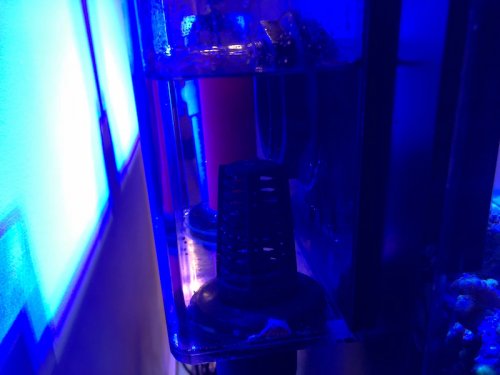HERBIE OVERFLOW
If you employ a Herbie overflow in your plumbing, could you add a photo, if practical, and your thought on it in your set up, such as problems, tips, or suggestions. I am trying to learn more about them and our NJRC members may as well.
In a reef tank, a Herbie overflow is a method employing a tuned siphon gravity drain method to bring aquarium water to a lower open sump with a safety overflow backup. Gravity provides the energy to drain water to a lower level. The main Herbie standpipe uses a siphon to drain the overflow/tank, even though this siphon never rises above the sump’s water surface. The siphon allows a much faster flow rate in the pipe. A precision valve is used to control the siphon flow fate. If the flow is perfect, the siphon removes water as fast as the return pump brings it back into the tank. If the drain removes water too fast, the syphon will break, causing large noise and fluctuating water levels. If it doesn’t drain water fast enough (or gets clogged) water will rise and overflow the tank unless or until it starts to flow down the emergency drain. The emergency drain must be able to drain this water faster than the pump can return it, so it often is a larger diameter drain. Since flow changes over time, there is usually some flow going down the emergency drain. The primary advantage of a Herbie it quiets typical drains and provides a backup.
If you are new to the hobby, or new to sump overflow plumbing, this is one or the three main types of overflow methods you may want to understand. Here is the best source I have found for the Herbie method.
http://gmacreef.com/herbie-overflow-reef-tank-plumbing-method-basics/
This diagram from the Marine Depot Website does a good job of simply describing the components of a Herbie Standpipe.

I noticed the new waterbox reef aquarium systems with sumps appear to employ the herbie overflow.

If you employ a Herbie overflow in your plumbing, could you add a photo, if practical, and your thought on it in your set up, such as problems, tips, or suggestions. I am trying to learn more about them and our NJRC members may as well.
In a reef tank, a Herbie overflow is a method employing a tuned siphon gravity drain method to bring aquarium water to a lower open sump with a safety overflow backup. Gravity provides the energy to drain water to a lower level. The main Herbie standpipe uses a siphon to drain the overflow/tank, even though this siphon never rises above the sump’s water surface. The siphon allows a much faster flow rate in the pipe. A precision valve is used to control the siphon flow fate. If the flow is perfect, the siphon removes water as fast as the return pump brings it back into the tank. If the drain removes water too fast, the syphon will break, causing large noise and fluctuating water levels. If it doesn’t drain water fast enough (or gets clogged) water will rise and overflow the tank unless or until it starts to flow down the emergency drain. The emergency drain must be able to drain this water faster than the pump can return it, so it often is a larger diameter drain. Since flow changes over time, there is usually some flow going down the emergency drain. The primary advantage of a Herbie it quiets typical drains and provides a backup.
If you are new to the hobby, or new to sump overflow plumbing, this is one or the three main types of overflow methods you may want to understand. Here is the best source I have found for the Herbie method.
http://gmacreef.com/herbie-overflow-reef-tank-plumbing-method-basics/
This diagram from the Marine Depot Website does a good job of simply describing the components of a Herbie Standpipe.

I noticed the new waterbox reef aquarium systems with sumps appear to employ the herbie overflow.



